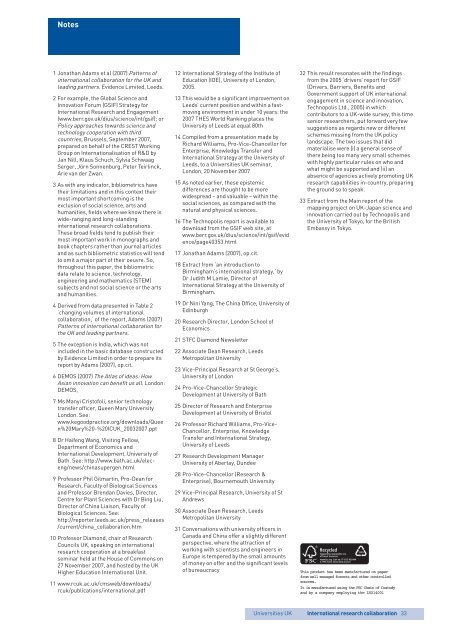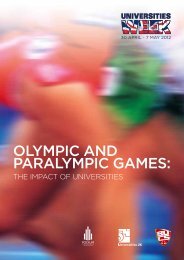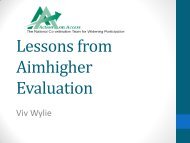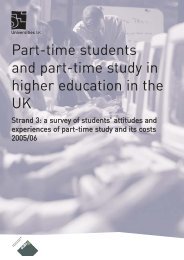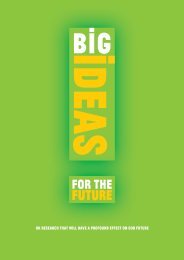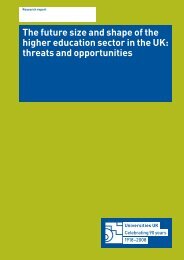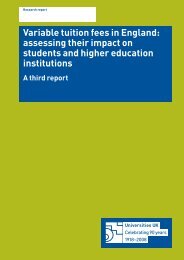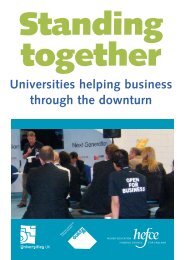International Research Collaboration - GlobalHigherEd
International Research Collaboration - GlobalHigherEd
International Research Collaboration - GlobalHigherEd
You also want an ePaper? Increase the reach of your titles
YUMPU automatically turns print PDFs into web optimized ePapers that Google loves.
NotesSectionA head1 Jonathan Adams et al (2007) Patterns ofinternational collaboration for the UK andleading partners. Evidence Limited, Leeds.2 For example, the Global Science andInnovation Forum (GSIF) Strategy for<strong>International</strong> <strong>Research</strong> and Engagement(www.berr.gov.uk/dius/science/int/gsif); orPolicy approaches towards science andtechnology cooperation with thirdcountries, Brussels, September 2007,prepared on behalf of the CREST WorkingGroup on <strong>International</strong>isation of R&D byJan Nill, Klaus Schuch, Sylvia SchwaagSerger, Jörn Sonnenburg, Peter Teirlinck,Arie van der Zwan.3 As with any indicator, bibliometrics havetheir limitations and in this context theirmost important shortcoming is theexclusion of social science, arts andhumanities, fields where we know there iswide-ranging and long-standinginternational research collaborations.These broad fields tend to publish theirmost important work in monographs andbook chapters rather than journal articlesand as such bibliometric statistics will tendto omit a major part of their oeuvre. So,throughout this paper, the bibliometricdata relate to science, technology,engineering and mathematics (STEM)subjects and not social science or the artsand humanities.4 Derived from data presented in Table 2‘changing volumes of internationalcollaboration,’ of the report, Adams (2007)Patterns of international collaboration forthe UK and leading partners.5 The exception is India, which was notincluded in the basic database constructedby Evidence Limited in order to prepare itsreport by Adams (2007), op.cit.6 DEMOS (2007) The Atlas of ideas: HowAsian innovation can benefit us all. London:DEMOS,7 Ms Manyi Cristofoli, senior technologytransfer officer, Queen Mary UniversityLondon. See:www.kegoodpractice.org/downloads/Queen%20Mary%20-%20ICUK_20032007.ppt8 Dr Haifeng Wang, Visiting Fellow,Department of Economics and<strong>International</strong> Development, University ofBath. See: http://www.bath.ac.uk/eleceng/news/chinasupergen.html9 Professor Phil Gilmartin, Pro-Dean for<strong>Research</strong>, Faculty of Biological Sciencesand Professor Brendan Davies, Director,Centre for Plant Sciences with Dr Bing Liu,Director of China Liaison, Faculty ofBiological Sciences. See:http://reporter.leeds.ac.uk/press_releases/current/china_collaboration.htm10 Professor Diamond, chair of <strong>Research</strong>Councils UK, speaking on internationalresearch cooperation at a breakfastseminar held at the House of Commons on27 November 2007, and hosted by the UKHigher Education <strong>International</strong> Unit.11 www.rcuk.ac.uk/cmsweb/downloads/rcuk/publications/international.pdf12 <strong>International</strong> Strategy of the Institute ofEducation (IOE), University of London,2005.13 This would be a significant improvement onLeeds’ current position and within a fastmovingenvironment in under 10 years: the2007 THES World Ranking places theUniversity of Leeds at equal 80th14 Compiled from a presentation made byRichard Williams, Pro-Vice-Chancellor forEnterprise, Knowledge Transfer and<strong>International</strong> Strategy at the University ofLeeds, to a Universities UK seminar,London, 20 November 200715 As noted earlier, these epistemicdifferences are thought to be morewidespread – and valuable – within thesocial sciences, as compared with thenatural and physical sciences.16 The Technopolis report is available todownload from the GSIF web site, atwww.berr.gov.uk/dius/science/int/gsif/evidence/page40353.html17 Jonathan Adams (2007), op.cit.18 Extract from ‘an introduction toBirmingham’s international strategy,’ byDr Judith M Lamie, Director of<strong>International</strong> Strategy at the University ofBirmingham.19 Dr Nini Yang, The China Office, University ofEdinburgh20 <strong>Research</strong> Director, London School ofEconomics21 STFC Diamond Newsletter22 Associate Dean <strong>Research</strong>, LeedsMetropolitan University23 Vice-Principal <strong>Research</strong> at St George’s,University of London24 Pro-Vice-Chancellor StrategicDevelopment at University of Bath25 Director of <strong>Research</strong> and EnterpriseDevelopment at University of Bristol26 Professor Richard Williams, Pro-Vice-Chancellor, Enterprise, KnowledgeTransfer and <strong>International</strong> Strategy,University of Leeds27 <strong>Research</strong> Development ManagerUniversity of Abertay, Dundee28 Pro-Vice-Chancellor (<strong>Research</strong> &Enterprise), Bournemouth University29 Vice-Principal <strong>Research</strong>, University of StAndrews30 Associate Dean <strong>Research</strong>, LeedsMetropolitan University31 Conversations with university officers inCanada and China offer a slightly differentperspective, where the attraction ofworking with scientists and engineers inEurope is tempered by the small amountsof money on offer and the significant levelsof bureaucracy32 This result resonates with the findingsfrom the 2005 ‘drivers’ report for GSIF(Drivers, Barriers, Benefits andGovernment support of UK internationalengagement in science and innovation,Technopolis Ltd., 2005) in whichcontributors to a UK-wide survey, this timesenior researchers, put forward very fewsuggestions as regards new or differentschemes missing from the UK policylandscape. The two issues that didmaterialise were (i) a general sense ofthere being too many very small schemeswith highly particular rules on who andwhat might be supported and (ii) anabsence of agencies actively promoting UKresearch capabilities in-country, preparingthe ground so to speak.33 Extract from the Main report of themapping project on UK-Japan science andinnovation carried out by Technopolis andthe University of Tokyo, for the BritishEmbassy in Tokyo.100%This product has been manufactured on paperfrom well managed forests and other controlledsources.It is manufactured using the FSC Chain of Custodyand by a company employing the ISO14001Universities UK<strong>International</strong> research collaboration33


